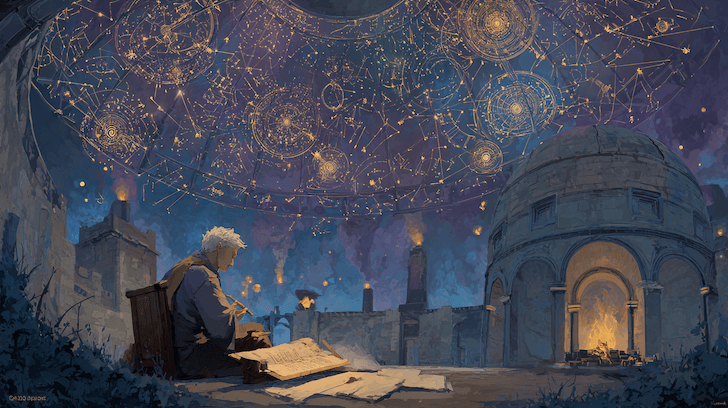The Origins of the Zodiac

The zodiac is one of humanity’s oldest frameworks for understanding the heavens. Long before it became the backbone of astrology, it was a tool for tracking time, seasons, and celestial cycles. Its story spans thousands of years—from ancient Babylon to Hellenistic Alexandria—and shows how stargazing evolved into symbolic language.
“Zodiac” comes from the Greek zōidiakos kyklos, meaning “circle of little animals.” It reflects the twelve constellations that the Sun appears to move through over the course of a year.
Early Roots — Babylon and the Birth of the Ecliptic (~2000–500 BCE)
The zodiac’s roots trace to Mesopotamia, where priests tracked planetary movements for omens and calendars. By the first millennium BCE, Babylonian astronomer-priests had mapped the Sun’s yearly path—called the ecliptic—and divided it into twelve equal segments of 30° each.
- These segments originally corresponded to constellations that rose behind the Sun at different times of year.
- Around 450 BCE, this system stabilized into the twelve-sign zodiac we recognize today: Aries, Taurus, Gemini, Cancer, Leo, Virgo, Libra, Scorpio, Sagittarius, Capricorn, Aquarius, and Pisces.
- Each sign represented seasonal qualities and agricultural timing, not just star imagery.
| Sign | Babylonian Origin | Approximate Constellation Reference |
|---|---|---|
| Aries | The Hired Worker | Lamb or Ram constellation at spring equinox |
| Taurus | The Heavenly Bull | Bull constellation at planting season |
| Gemini | The Great Twins | Castor and Pollux stars |
| Cancer | The Crab | Summer solstice sign—turning of the Sun |
| Leo | The Lion | Regulus star at high summer |
| Virgo | The Maiden | Harvest period constellation |
| Libra | The Scales | Equinox balance point |
| Scorpio | The Scorpion | Autumn hunter and underworld imagery |
| Sagittarius | The Archer | Half-human archer with celestial aim |
| Capricorn | The Goat-Fish | Winter solstice hybrid symbol |
| Aquarius | The Water-Bearer | Flood season bringer |
| Pisces | The Fish | Spring flood and renewal imagery |
Originally, the signs were constellations, but over time, astrologers abstracted them into 30° symbolic segments starting at the equinox—a major shift.
Greek Adaptation — The Tropical Zodiac (5th–2nd c. BCE)
When Babylonian knowledge entered Greece and Egypt, philosophers reinterpreted it through geometry and elemental theory. The Hellenistic astrologers in Alexandria formalized what’s called the tropical zodiac—anchoring 0° Aries to the spring equinox, not to fixed stars.
- This turned the zodiac from a stellar to a seasonal system.
- It aligned astrology with natural cycles—growth, peak, harvest, and rest.
- The twelve signs gained elemental (Fire, Earth, Air, Water) and modal (Cardinal, Fixed, Mutable) qualities.
- Early astrologers like Ptolemy and Vettius Valens used this model in their horoscopes.
| Era | Zodiac Type | Anchor Point |
|---|---|---|
| Babylonian | Sidereal (star-based) | Fixed constellations along ecliptic |
| Hellenistic | Tropical (season-based) | Spring equinox at 0° Aries |
Constellations vs. Signs
It’s important to remember: constellations and zodiac signs are not the same. The twelve signs are equal slices of the ecliptic, while constellations are unequal patches of stars. Over centuries, Earth’s axial precession—a slow wobble—shifted the constellations relative to the equinox points.
- The sidereal zodiac (used in Indian astrology) keeps its anchor to the stars.
- The tropical zodiac (used in Western astrology) keeps its anchor to the seasons.
- The roughly 24° offset between them grows by about 1° every 72 years.
This is why “your sign” in Western astrology doesn’t match where the Sun literally sits among the constellations today—it’s symbolic, not astronomical.
Medieval and Modern Adaptations
Through Persian and Arabic scholars, the zodiac survived into the medieval world. Translators like Abū Maʿshar and Al-Qabīṣī integrated it into astronomy and medicine. In the Renaissance, astrologers such as William Lilly popularized the twelve-sign system across Europe.
By the 19th and 20th centuries, astrology shifted again:
- Psychological astrology reframed signs as archetypes of personality rather than fate.
- The discovery of Uranus, Neptune, and Pluto extended rulerships beyond Saturn.
- Astrocartography, modern transits, and outer-planet cycles added layers of interpretation.
The zodiac’s framework hasn’t changed in 2,000 years—but what we do with it has evolved dramatically.
The Zodiac’s Modern Shape
Today, the zodiac is used both symbolically and culturally—in art, personality typing, and seasonal mindfulness. Astrologers use the tropical zodiac to read patterns of psyche and timing, while astronomers chart the actual constellations behind it.
You can think of the zodiac as a bridge:
- Between sky and psyche
- Between ancient observation and modern interpretation
- Between calendar and consciousness
Summary
The zodiac began as a calendar of the heavens, mapping the Sun’s annual path through twelve constellations. Over millennia, it evolved from astronomy to symbolism, from omens to archetypes, and from temple ceilings to smartphone apps.
What endures is its rhythm—a cosmic mirror of life’s cycles, linking the patterns of the sky with the stories we tell on Earth.
The zodiac isn’t a fixed map—it’s a 3,000-year conversation between skywatchers and meaning-makers. Every era reinterprets the same circle.
History of Astrology

Sign Meanings

Get Your Birth Chart
Calculate your complete astrological chart with precise astronomical data based on your birth time and location
Generate Chart